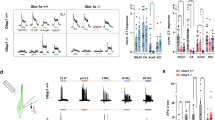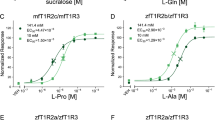Abstract
Sensory transduction for many taste stimuli such as sugars, some bitter compounds and amino acids is thought to be mediated via G protein-coupled receptors (GPCRs), although no such receptors that respond to taste stimuli are yet identified. Monosodium L-glutamate (l-MSG), a natural component of many foods, is an important gustatory stimulus believed to signal dietary protein. We describe a GPCR cloned from rat taste buds and functionally expressed in CHO cells. The receptor couples negatively to a cAMP cascade and shows an unusual concentration–response relationship. The similarity of its properties to MSG taste suggests that this receptor is a taste receptor for glutamate.
This is a preview of subscription content, access via your institution
Access options
Subscribe to this journal
Receive 12 print issues and online access
$209.00 per year
only $17.42 per issue
Buy this article
- Purchase on Springer Link
- Instant access to full article PDF
Prices may be subject to local taxes which are calculated during checkout




Similar content being viewed by others
References
Lindemann, B. Taste reception. Physiol. Rev. 76, 719– 766 (1996).
Lindemann, B. Receptor seeks ligand: on the way to cloning the molecular receptors for sweet and bitter taste. Nat. Med. 5, 381– 382 (1999).
McLaughlin, S. K., McKinnon, P. J. & Margolskee, R. F. Gustducin is a taste-cell-specific G protein closely related to the transducins. Nature 357, 563–569 (1992).
McLaughlin, S. K., McKinnon, P. J., Spickofsky, N., Danho, W. & Margolskee, R. F. Molecular cloning of G proteins and phosphodiesterases from rat taste cells. Physiol. Behav. 56, 1157–1164 (1994).
Kusakabe, Y., Abe, K., Tanemura, K., Emori, Y. & Arai, S. GUST27 and closely related G-protein-coupled receptors are localized in taste buds together with Gi-protein α-subunit. Chem. Senses 21, 335–340 ( 1996).
Kusakabe, Y. et al. Identification of two alpha-subunit species of GTP-binding proteins, Ga15 and Gaq, expressed in rat taste buds. Biochim. Biophys. Acta 1403, 265–272 ( 1998).
Huang, L. et al. Gγ13 colocalizes with gustducin in taste receptor cells and mediates IP3 responses to bitter denatonium. Nat. Neurosci. 2, 1055–1062 ( 1999).
Misaka, T. et al. Taste buds have a cyclic nucleotide-activated channel, CNGgust . J. Biol. Chem. 272, 22623– 22629 (1997).
Kretz, O., Barbry, P., Bock, R. & Lindemann, B. Differential expression of RNA and protein of the three pore-forming subunits of the amiloride-sensitive epithelial sodium channel in taste buds of the rat. J. Histochem. Cytochem. 47, 51–64 ( 1999).
Lin, W., Finger, T. E., Rossier, B. C. & Kinnamon, S. C. Epithelial Na+ channel subunits in rat taste cells: localization and regulation by aldosterone. J. Comp. Neurol. 405 , 406–420 (1999).
Ogawa, S. et al. Receptor that leaves a sour taste in the mouth. Nature 395, 555–556 ( 1998).
Ming, D., Ruiz-Avila, L. & Margolskee, R. F. Characterization and solubilization of bitter-responsive receptors that couple to gustducin. Proc. Natl. Acad. Sci. USA 95, 8933–8938 ( 1998).
Matsuoka, I., Mori, T., Aoki, J., Sato, T. & Kurihara, K. Identification of novel members of G-protein coupled receptor superfamily expressed in bovine taste tissue. Biochem. Biophys. Res. Commun. 194, 504–511 (1993).
Abe, K., Kusakabe, Y., Tanemura, K., Emori, Y. & Arai, S. Primary structure and cell-type specific expression of a gustatory G protein-coupled receptor related to olfactory receptors. J. Biol. Chem. 268, 12033– 12039 (1993).
Hoon, M. A. et al. Putative mammalian taste receptors: a class of taste-specific GPCRs with distinct topographic selectivity. Cell 96 , 541–551 (1999).
Faurion, A. Are umami taste receptor sites structurally related to glutamate CNS receptor sites? Physiol. Behav. 49, 905– 912 (1991).
Chaudhari, N. et al. The taste of monosodium glutamate: Membrane receptors in taste buds. J. Neurosci. 16, 3817– 3826 (1996).
Hayashi, Y., Zviman, M. M., Brand, J. G., Teeter, J. H. & Restrepo, D. Measurement of membrane potential and [Ca2+]i in cell ensembles: Application to the study of glutamate taste in mice. Biophys. J. 71, 1057–1070 (1996).
Conn, P. J. & Pin, J. P. Pharmacology and functions of metabotropic glutamate receptors. Annu. Rev. Pharmacol. Toxicol. 37, 205–237 (1997).
Chaudhari, N. & Roper, S. D. Molecular and physiological evidence for glutamate (umami) taste transduction via a G protein-coupled receptor . Ann. NY Acad. Sci. 855, 398– 406 (1998).
Yang, H., Wanner, I. B., Roper, S. D. & Chaudhari, N. An optimized method for in situ hybridization with signal amplification that allows the detection of rare mRNAs. J. Histochem. Cytochem. 47 431–446 ( 1999).
Kurihara, K. & Kashiwayanagi, M. Introductory remarks on umami taste. Ann. NY Acad. Sci. 855, 393– 397 (1998).
Sako, N. & Yamamoto, T. Analyses of taste nerve responses with special reference to possible receptor mechanisms of umami taste in the rat. Neurosci. Lett. 261, 109– 112 (1999).
Delay, E. R. et al. Taste preference synergism between glutamate receptor ligands and IMP in rats. Chem. Senses (in press).
Lin, W. & Kinnamon, S.C. Physiological evidence for ionotropic and metabotropic glutamate receptors in rat taste cells. J. Neurophysiol. 82, 2061–2069 ( 1999).
Ninomiya, Y., Tanikukai, T., Yoshida, S., Funakoshi, M. & Tanimukai, T. Gustatory neural responses in preweanling mice. Physiol. Behav. 49, 913 –918 (1991).
Yamamoto, T. et al. Electrophysiological and behavioural studies on the taste of umami substances in the rat. Physiol. Behav. 49, 919–925 (1991).
Monastyrskaia, K. et al. Effect of the umami peptides on the ligand binding and function of rat mGlu4a receptor might implicate this receptor in the monosodium glutamate taste transduction. Br. J. Pharmacol. 128 , 1027–1034 (1999).
O'Hara, P. J. et al. The ligand-binding domain in metabotropic glutamate receptors is related to bacterial periplasmic binding proteins. Neuron 11, 41–52 (1993).
Han, G. & Hampson, D. R. Ligand binding to the amino-terminal domain of the mGluR4 subtype of metabotropic glutamate receptor. J. Biol. Chem. 274, 10008–10013 (1999).
Takahashi, K., Tsuchida, K., Tanabe, Y., Masu, M. & Nakanishi, S. Role of the large extracellular domain of metabotropic glutamate receptors in agonist selectivity determination. J. Biol. Chem. 268, 19341–19345 ( 1993).
Thomsen, C. et al. Cloning and characterization of a metabotropic glutamate receptor, mGluR4b. Neuropharmacology 36, 21– 30 (1997).
Tanabe, Y., Masu, M., Ishii, T., Shigemoto, R. & Nakanishi, S. A family of metabotropic glutamate receptors. Neuron 8, 169–179 ( 1992).
Bradley, S. R., Levey, A. I., Hersch, S. M. & Conn, P. J. Immunocytochemical localization of group III metabotropic glutamate receptors in the hippocampus with subtype-specific antibodies. J. Neurosci. 16, 2044–2056 ( 1996).
Tanabe, Y. et al. Signal transduction, pharmacological properties and expression patterns of two rat metabotropic glutamate receptors, mGluR3 and mGluR4. J. Neurosci. 13, 1372–1378 (1993).
Hettinger, T. P., Frank, M. E. & Myers, W. E. Are the tastes of polycose and monosodium glutamate unique? Chem. Senses 21, 341– 347 (1996).
Rifkin, B. & Bartoshuk, L.M. Taste synergism between monosodium glutamate and disodium 5′-guanylate. Physiol. Behav. 24, 1169–1172 (1980).
Torii, K. & Cagan, R. H. Biochemical studies of taste sensation. IX. Enhancement of L-[3H]glutamate binding to bovine taste papillae by 5′-ribonucleotides. Biochim. Biophys. Acta 627, 313–323 (1980).
Caicedo, A., Kim, K. & Roper, S. Glutamate-induced cobalt uptake reveals non-NMDA receptors in rat taste cells . J. Comp. Neurol. (in press).
Bigiani, A., Delay, R. J., Chaudhari, N., Kinnamon, S. C. & Roper, S. D. Responses to glutamate in rat taste cells. J. Neurophysiol. 77, 3048– 3059 (1997).
Pin, J. P. & Duvoisin, R. The metabotropic glutamate receptors: structure and functions. Neuropharmacology 34, 1–26 (1995).
Pin, J.-P., Waeber, C., Prezeau, L., Bockaert, J. & Heinemann, S. F. Alternative splicing generates metabotropic glutamate receptors inducing different patterns of calcium release in Xenopus oocytes. Proc. Natl. Acad. Sci. USA 89, 10331–10335 (1992).
Yamaguchi, S. & Nakanishi, S. Regional expression and regulation of alternative forms of mRNAs derived from two distinct transcription initiation sites of the rat mGluR5 gene. J. Neurochem. 71, 60–68 (1998).
Frohman, M. A., Dush, M. K. & Martin, G. R. Rapid production of full-length cDNAs from rare transcripts: amplification using a single gene-specific oligonucleotide primer. Proc. Natl. Acad. Sci. USA 85, 8998– 9002 (1988).
Towbin, H., Staehelin, T. & Bordon, J. Electrophoretic transfer of proteins from polyacrylamide gels to nitrocellulose sheets: Procedure and some applications. Proc. Natl. Acad. Sci. USA 76, 4350– 4354 (1979).
Acknowledgements
This work was supported by grants from NIH/NIDCD (DC 03013) and from Cultor Food Science, Inc. We are also grateful for support from the Umami Manufacturers' Association of Japan during the early stages of this study. We acknowledge technical assistance from Cynthia Lamp and Helena de Carvalho.
Author information
Authors and Affiliations
Corresponding author
Rights and permissions
About this article
Cite this article
Chaudhari, N., Landin, A. & Roper, S. A metabotropic glutamate receptor variant functions as a taste receptor . Nat Neurosci 3, 113–119 (2000). https://doi.org/10.1038/72053
Received:
Accepted:
Issue Date:
DOI: https://doi.org/10.1038/72053
This article is cited by
-
The flavor-enhancing action of glutamate and its mechanism involving the notion of kokumi
npj Science of Food (2023)
-
Photoelectrocatalytic biosynthesis fuelled by microplastics
Nature Synthesis (2022)
-
Taste alterations during neo/adjuvant chemotherapy and subsequent follow-up in breast cancer patients: a prospective single-center clinical study
Supportive Care in Cancer (2022)
-
A metabolomics comparison in milk from two Dezhou donkey strains
European Food Research and Technology (2022)



